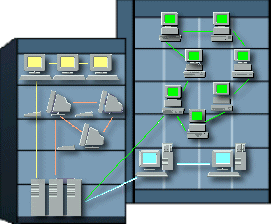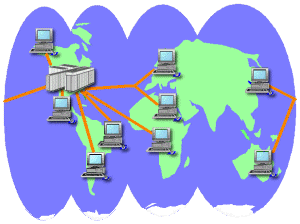Jan's Computer Basics:
Computer to Computer: Networks
A network is a set of computers which are linked together on a permanent basis. This can mean two computers cabled together on the same desk, or thousands of computers across the world. The connections can be cables or wireless.

Network made up of a server, connected desktop computers,
a shared network printer, a laptop connected wirelessly
| Advantages: |
|
| Disadvantages: |
|
LAN
|
A LAN is a Local Area Network. This would include networks where the computers are relatively close together. So LANs would be within the same office, a single building, or several buildings close together. A small LAN is often set up just to provide Internet access to all the computers in a small office or a home. Sharing a printer or scanner is also a good reason for a small LAN.
|
 |
WAN
|
A WAN is a Wide Area Network, which would be all networks too large to be LANs. There doesn't seem to be a clear line between the two designations. A WAN would be most useful for large companies with offices or factories in widely separated areas, like Microsoft, IBM, Ford, AT&T, etc. The same advantages apply as for a LAN except that a WAN would not share an Internet connection. Often a WAN uses the Internet to connect with instead of dedicated cables between far distant computers. But you can still set up remote access for computers and hardware over a WAN. |
 |
